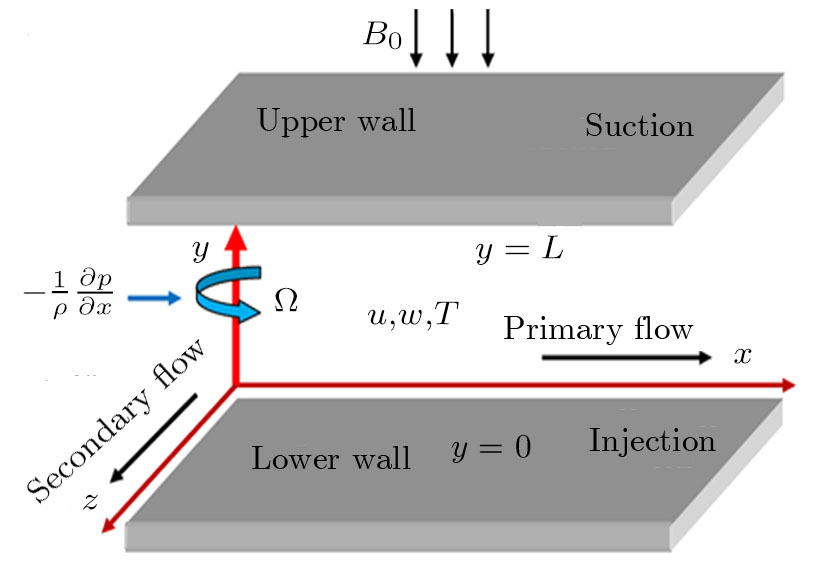† Corresponding author. E-mail:
Support of the National Natural Science Foundation of China under Grant Nos. 51709191 and 51706149, and Key Laboratory of Advanced Reactor Engineering and Safety, Ministry of Education under Grant No. ARES-2018-10
This article investigates an unbiased analysis for the unsteady two-dimensional laminar flow of an incompressible, electrically and thermally conducting fluid across the space separated by two infinite rotating permeable walls. The influence of entropy generation, Hall and slip effects are considered within the flow analysis. The problem is modeled based on valid physical arguments and the unsteady system of dimensionless PDEs (partial differential equations) are solved with the help of Finite Difference Scheme. In the presence of pertinent parameters, the precise movement of the flow in terms of velocity, temperature, entropy generation rate, and Bejan numbers are presented graphically, which are parabolic in nature. Streamline profiles are also presented, which exemplify the accurate movement of the flow. The current study is one of the infrequent contributions to the existing literature as previous studies have not attempted to solve the system of high order non-linear PDEs for the unsteady flow with entropy generation and Hall effects in a permeable rotating channel. It is expected that the current analysis would provide a platform for solving the system of nonlinear PDEs of the other unexplored models that are associated to the two-dimensional unsteady flow in a rotating channel.
Entropy generation determines the performance of thermal machines such as heat engines, power plants, heat pumps, refrigerators and air conditioners. It performs a significant part in the thermodynamics of irreversible processes, which is briefly explained by de Groot and Mazur.[1] In recent years, the analysis of entropy generation has widely been used for the investigation of thermal processes. Entropy forms the foundation of most of the formulations of thermodynamics. Entropy generation analysis appears as a powerful tool to optimize efficiency of various heat transfer and fluids engineering devices. Identification of various conditions for exergetic effectiveness enhancement to occur would serve as a useful theoretical tool for the design and thermodynamic efficiency characterization of such an integrated system. Bejan[1] studied the entropy generation in fundamental convective heat transfer and explored that in convective fluid flow, entropy generation is due to viscous shear stresses and heat transfer. One of the aims of entropy generation is to minimize the heat transfer irreversibility and viscous dissipation irreversibility. The process of irreversibility exists inside the cavity during the process of convection. To retain the energy, it is essential to vanish the process of irreversibility.[1–2] The combined effects of hydrodynamic slip, suction or injection and convective boundary conditions on the global entropy generation in a steady flow of an incompressible MHD fluid through a channel with permeable plates has been investigated by Guillermo.[3] Eegunjobi and Makinde[4] examined the analysis of entropy generation in a variable viscosity within the MHD flow with permeable walls and convective surface boundary conditions. Arikoglu et al.[5] explored the slip effects on entropy generation in MHD flow over a rotating disk by mean of a semi-numerical analytical solution technique.
Flows that are persuaded by the rotating disks are of considerable attention to the researchers and this is due to the physical phenomena of the flow within the rotating permeable or impermeable flow passages. The applications of such types of flows have emerged well in rotating machinery, lubrication, viscometer and crystal growth processes, etc.[3–8] Similarly, magnetic effects in lubrication have received a remarkable attention due to their substantial roles in industrial applications. Another significant factor within the MHD boundary layer analysis is the Hall effects. The Hall effects are substantial only when the applied magnetic field is very strong. Thus, the electric field as a result of polarization of charges and Hall effects becomes trivial. It has been briefly discussed by Ahmad.[9–11] A study in detail linked to Hall effects on free and forced convective flow in a rotating channel is investigated by Rao and Krishna.[12] Akbar and Khan[13] performed the entropy analysis for the Peristaltic flow of Cu-water nanofluid with magnetic field in a lopsided channel. Guria and Jana[14] examined the Hall effects on the hydromagnetic convective flow in a rotating channel. The unsteady two-dimensional MHD Couette flow in a rotating system with the Hall current and ion-slip current effects is examined by Jha and Apere.[15] Seth et al.[16] examined the combined free and forced convection Couette-Hartmann flow in a rotating channel with arbitrary conducting walls and Hall effects. Eegunjobi and Makinde[17] investigated the irreversibility in a variable viscosity Hartmann flow through a rotating permeable channel with Hall effects. Mabood et al.[18] investigated the MHD flow of a variable viscosity of the nanofluid in a rotating permeable channel with Hall effects. Makinde and Onyejekwe[19] found the numerical analysis of the two-dimensional MHD generalized Couette flow and heat transfer with variable viscosity. Makinde[20] solely performed the thermal decomposition of unsteady non-Newtonian MHD Couette flow with variable properties. Sheikholeslami et al.[21–22] have discussed interesting effects of non-uniform and variable magnetic fields on the flow of nanofluids.
In the above studies, the scholars have achieved numerous results, which are linked to the two-dimensional laminar boundary layer analysis of MHD flow with entropy generation in different permeable rotating flow passages. In all the above studies, they transformed the system of PDEs into a system of ODEs via similarity transformation and then solved the corresponding system of ODEs with suitable numerical or analytical technique. The coupled high order non-linear PDEs solutions in boundary layer analyses for the unsteady MHD flow and entropy generation in a rotating permeable microchannel are very rare and so far, it has not been explored. To cover the gap, it is essential to find the solution to the high order nonlinear PDEs for the current analysis as PDEs solution show us the exact trend of the fluid flow for any category of a flow in any flow microchannel. Practical application of the considered problem in the present study can be found in miniaturized electronic devices such as micromixers. Micromixing technology has experienced rapid development in the past few years. It is an essential component of integrated microfluidic system for chemical, biological and medical purposes. A well-designed micromixer has rapid mixing and compact in size. The thermal management in such devices has become a taxing issue. Micro-scale heat transfer becomes a topical subject and innovative techniques are needed to improve the thermal performance of heat sinks. For this purpose, a system of nonlinear PDEs solution has been obtained by mean of Finite Difference Scheme. In the understanding of recent studies, It is expected that the current analysis would provide a platform for solving the system of nonlinear PDEs of the other unexplored and unattempted fluid flow models that are associated to the two-dimensional unsteady flow in a rotating channel. It is believed that the current study would also be beneficial in cooling of electronic devices and heat exchangers.
Consider the unsteady flow of an incompressible, electrically and thermally conducting viscous Newtonian fluid through a microchannel with two rotating permeable walls at y = 0 and y = L under the action of an externally imposed transverse magnetic field B0 taken into account Hall current. Initially at τ ≤ 0, the fluid temperature is maintained at T0 and no flow occurs. When τ > 0, the flow occurs and both fluid and channel rotate simultaneously with a monotonous angular velocity Ω about y-axis under the combined actions of uniform pressure gradient applied along x-direction and the suction/injection at the channel walls (See Fig.
Bearing in mind the assumptions above, the governing equations of momentum and energy balance are given as[1–4]




The initial and boundary conditions for the fluid velocities and temperature are given as

Introducing the dimensionless variables and parameters as follows:








Finite Difference Method (FDM) serves as the basis for the numerical schemes (see Le Veque[23]). To achieve the time-dependent PDE numerical solution, both the implicit and explicit methods are widely used these days. In the current analysis, the dimensionless nonlinear second order parabolic partial differential equations i.e., Eqs. (
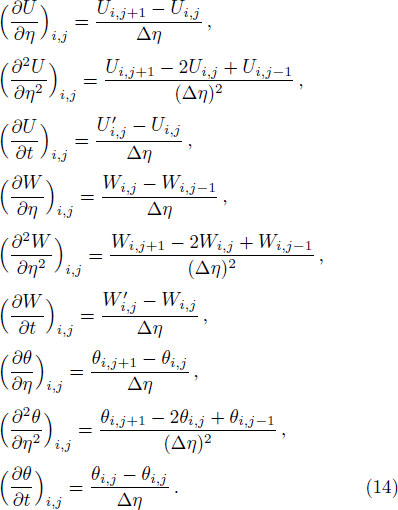














It has been seen, through numerical experimentation, that as the time steps increase, a stable implicit Finite difference scheme does not always reduce CPU time and the computations do not always remain stable. As the time step increases, there is an increase in CPU time and even unstable computations and this results in issues with convergence of the problem. The finite difference scheme is standard because its relaxed stability constraints can result in better computational efficiency. The stability of the simultaneous system of PDEs for a similar type of problem was presented by Callahan and Marner.[24] In the current analysis, both the small time and large time solutions have been obtained, which converge well for the selected small values of the parameters and then all the results have been shown graphically.
The problem of two-dimensional laminar flow of an incompressible fluid between two rotating permeable walls is studied. The influence of pertinent parameters on dimensionless velocities, temperature, skin friction, Nusselt number and entropy generation rate are investigated. Figures
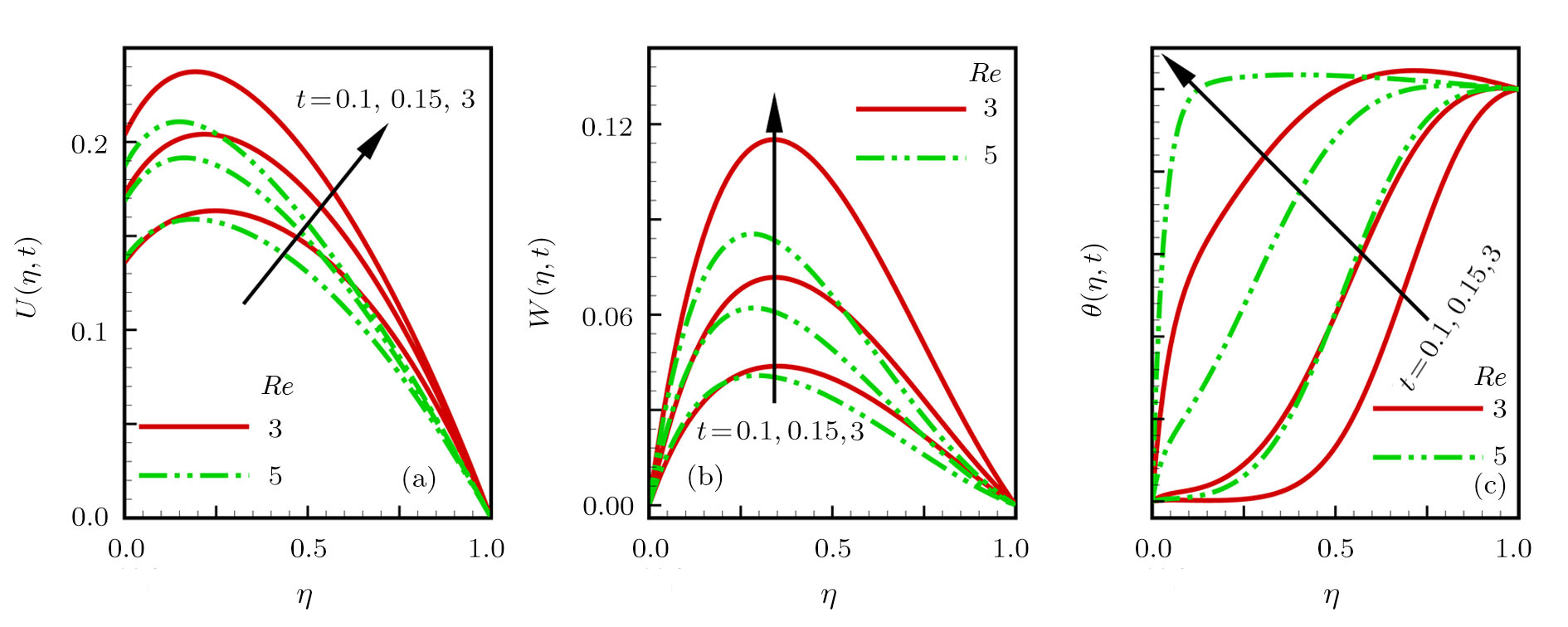 | Fig. 2 Effects of increasing time and Reynolds number on dimensionless (a) primary velocity, (b) secondary velocity and (c) temperature in transient state. |
The effects of rotation and slip parameters on the dimensionless primary and secondary velocities are demonstrated in Figs.
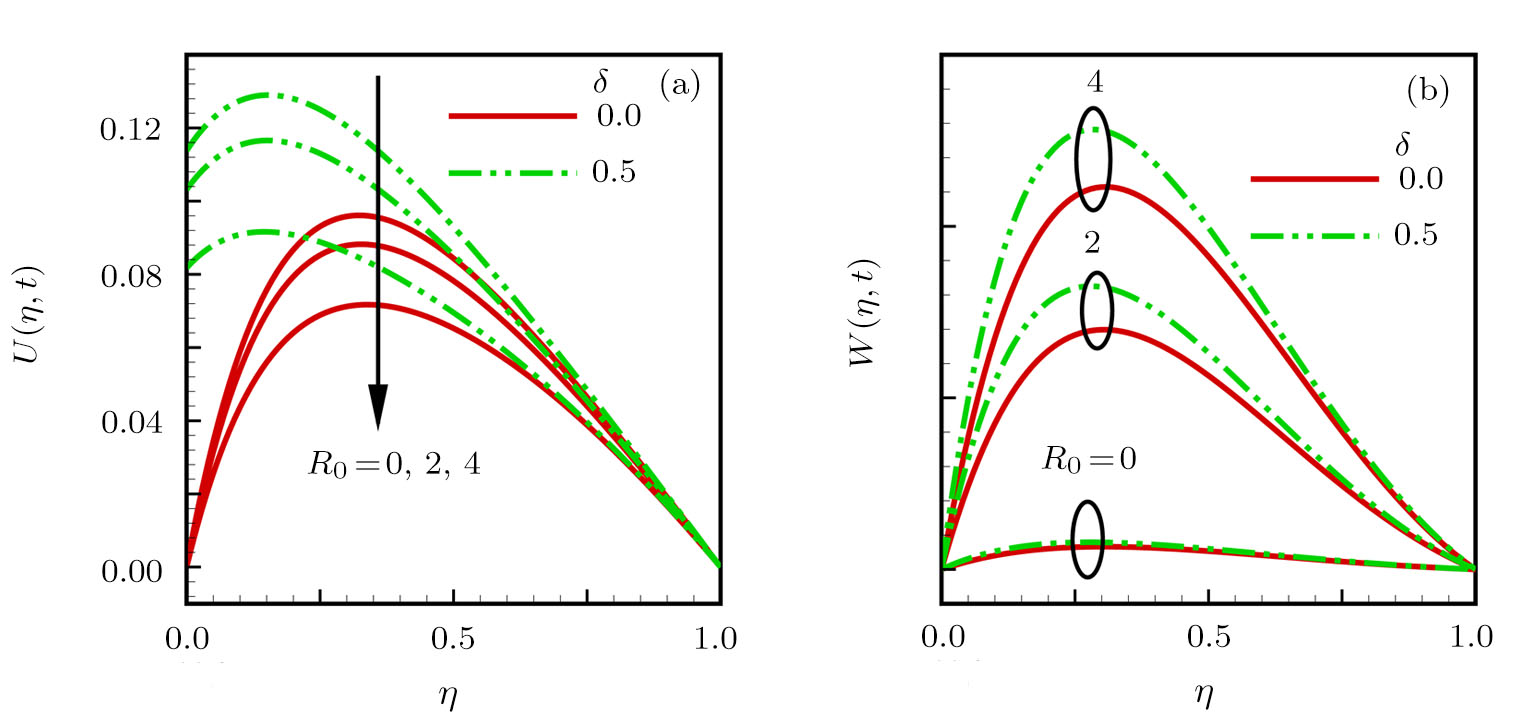 | Fig. 3 Effects of rotation and slip parameters on dimensionless (a) primary velocity and (b) secondary velocity (transient state). |
The variation in the rate of overall dimensionless entropy generation with rotational and slip parameters is shown in Fig.
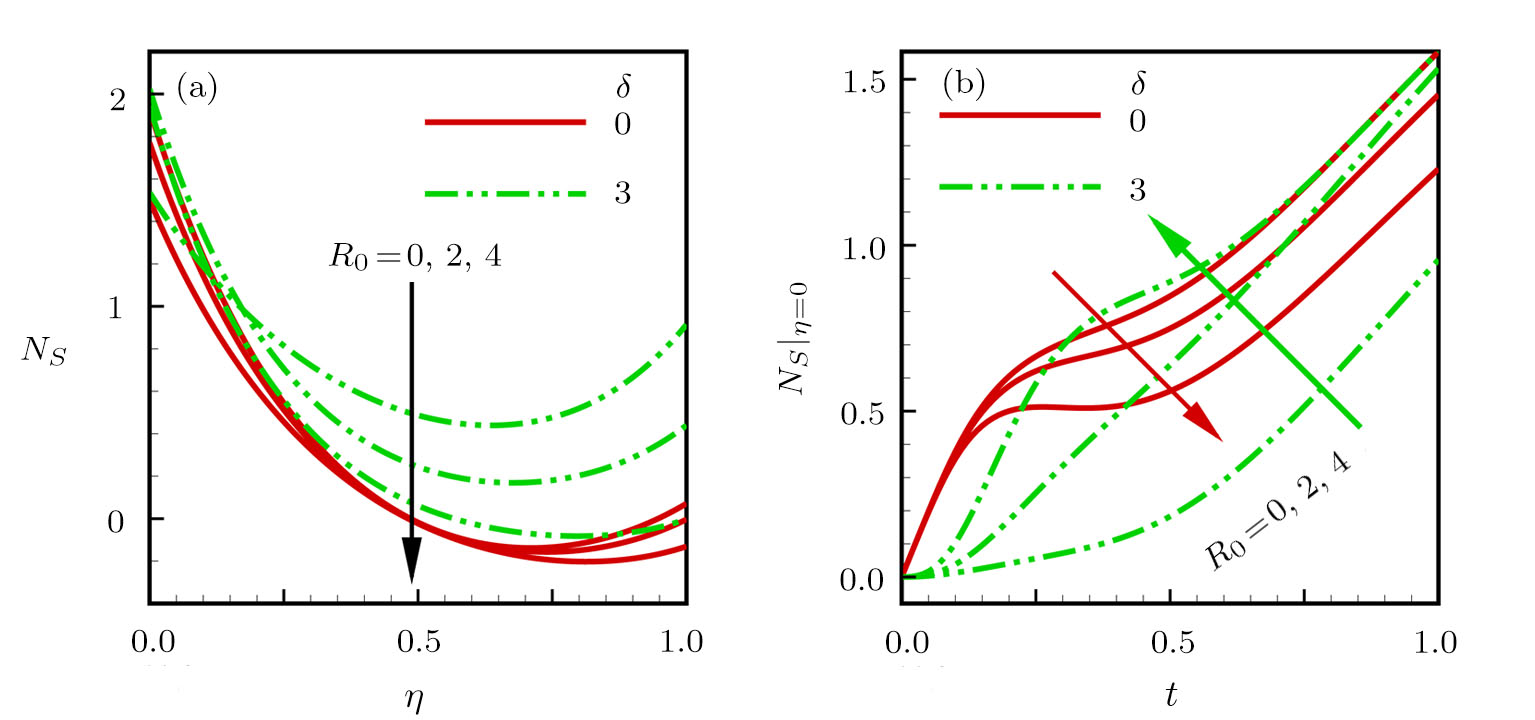 | Fig. 4 Effects of rotational and slip parameters on the dimensionless entropy generation rate for (a) steady state and (b) transient state. |
The effects of magnetic and Hall current parameters on the total dimensionless entropy generation rate are depicted in Fig.
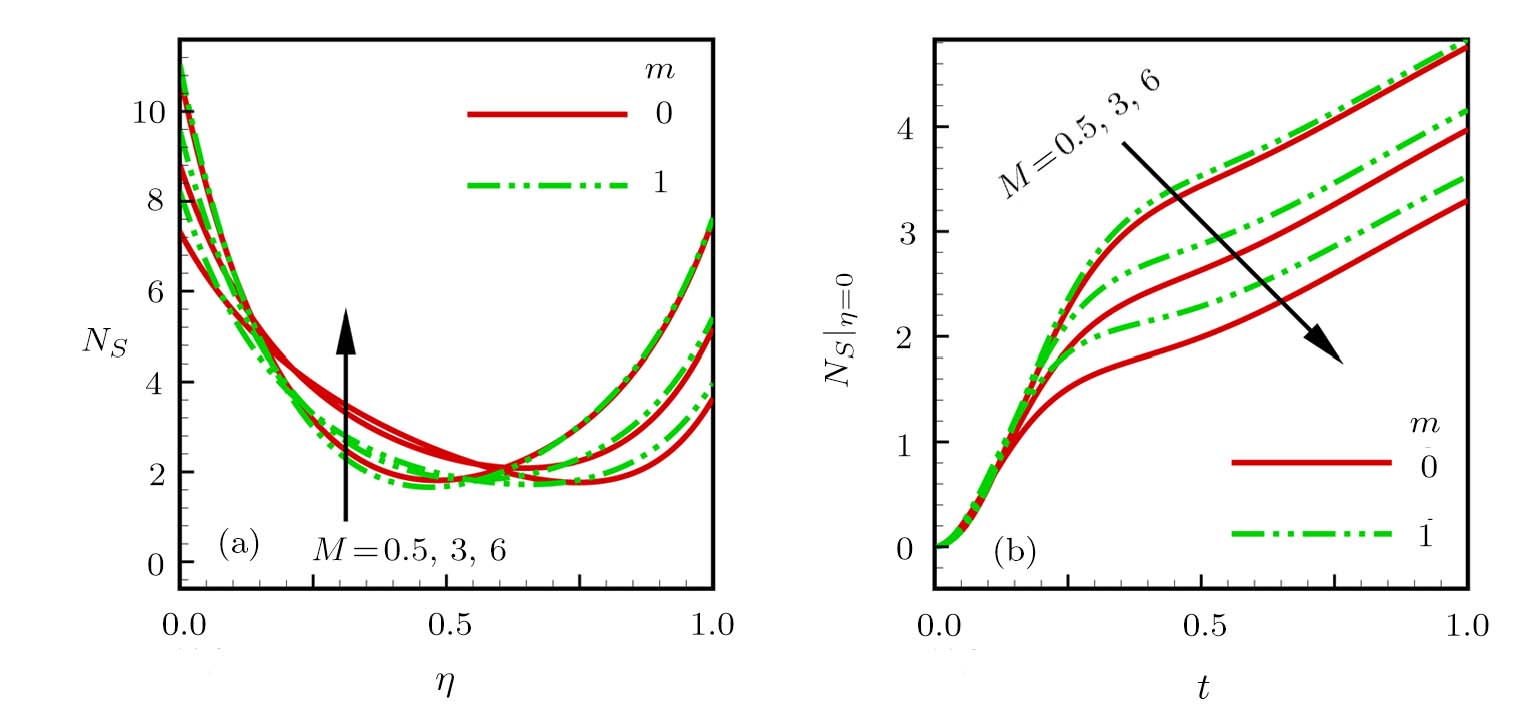 | Fig. 5 Effects of magnetic and Hall current parameters on the dimensionless entropy generation rate for (a) steady state and (b) transient state. |
The Eckert number characterizes heat dissipation in thermodynamic systems. The dimensionless entropy generation rate is based on the heat transfer and fluid friction. Both of these processes dissipate heat energy that determines the Eckert number. The Prandtl number dictates heat diffusion rate. The greater the Prandtl number, the slower is the heat diffusion rate. The effect of these numbers on the dimensionless entropy generation rate is shown in Figs.
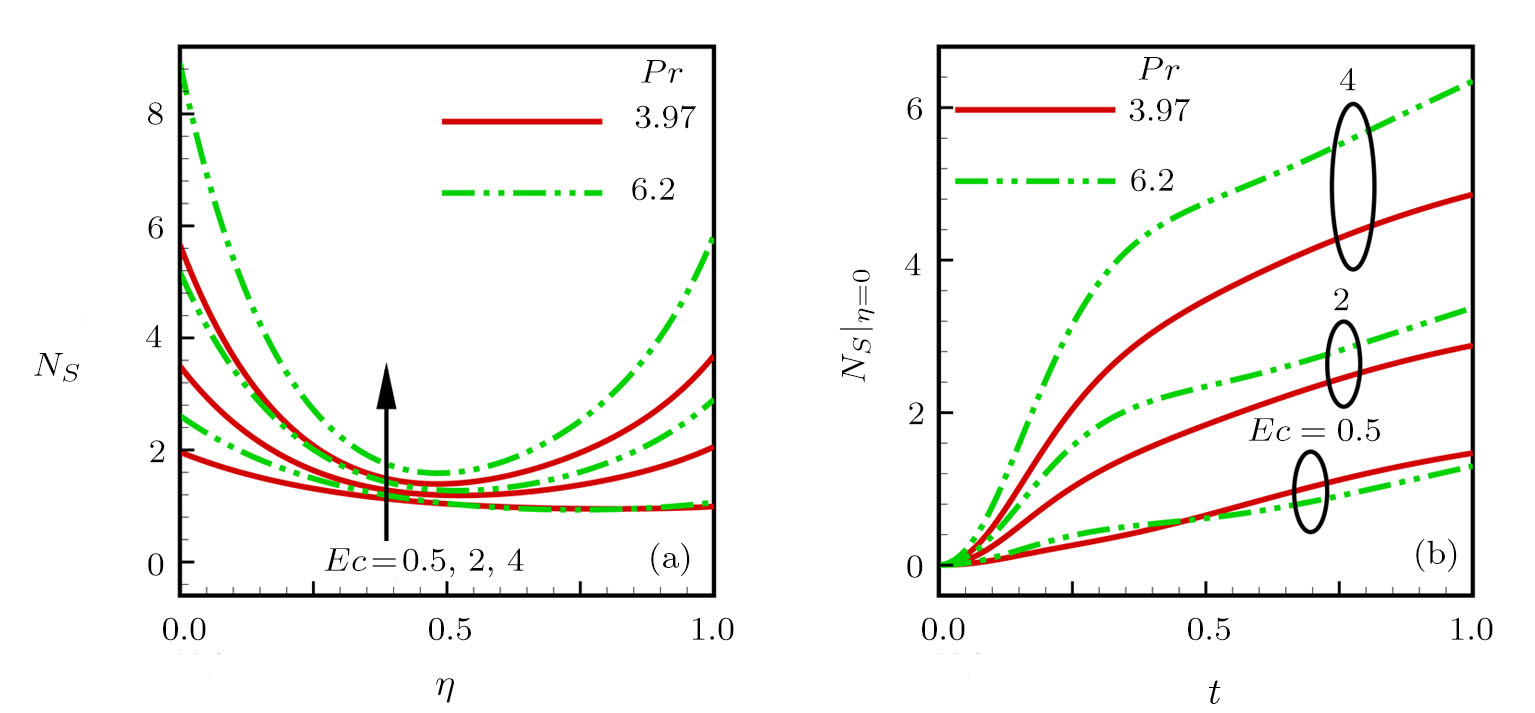 | Fig. 6 Effects of Eckert and Prandtl numbers on the dimensionless entropy generation rate for (a) steady state and (b) transient state. |
The effects of pertinent parameters on the Bejan number are displayed in Figs. Be → 0, fluid friction dominates. Be → 0.5, both fluid friction and heat transfer play the same role. Be → 1, the heat transfer dominates.
It is established that in Figs.
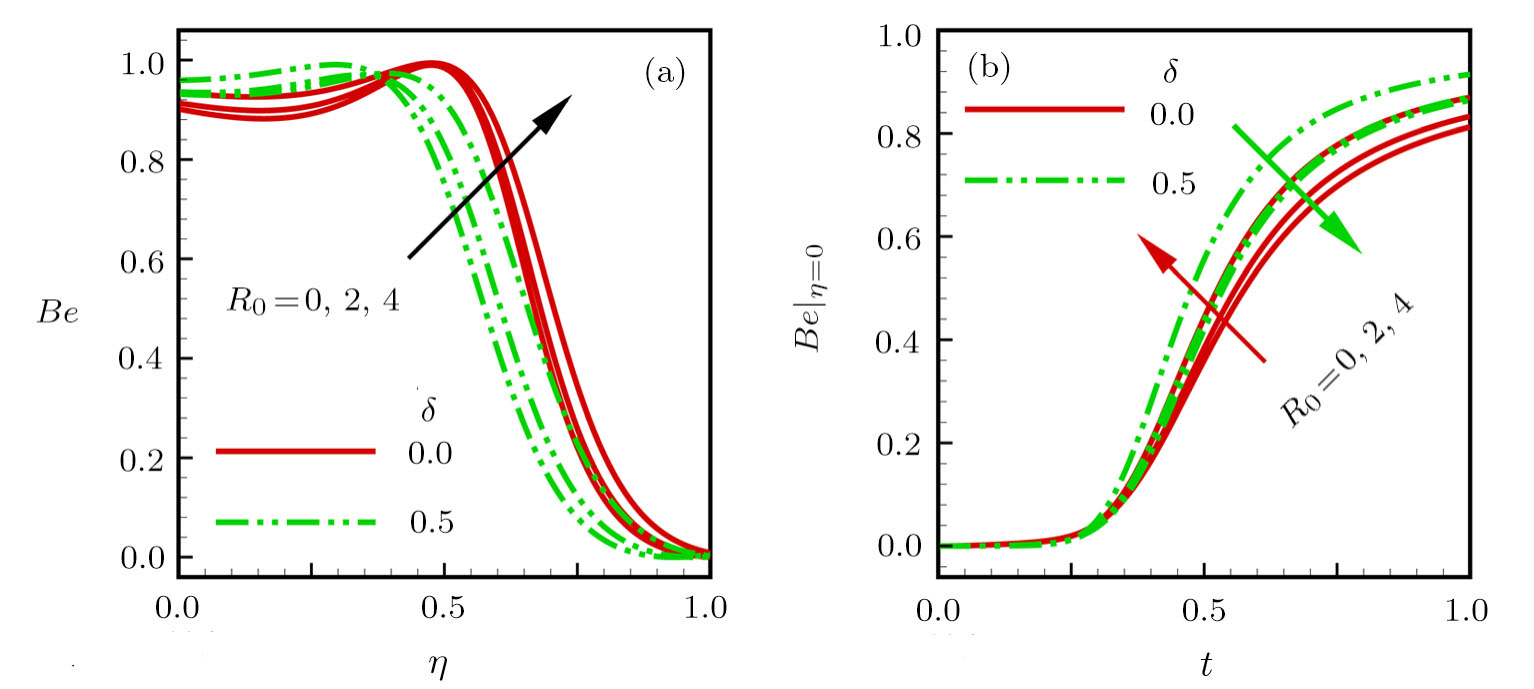 | Fig. 7 Effects of rotational and slip parameters on Bejan number for (a) steady state and (b) transient state. |
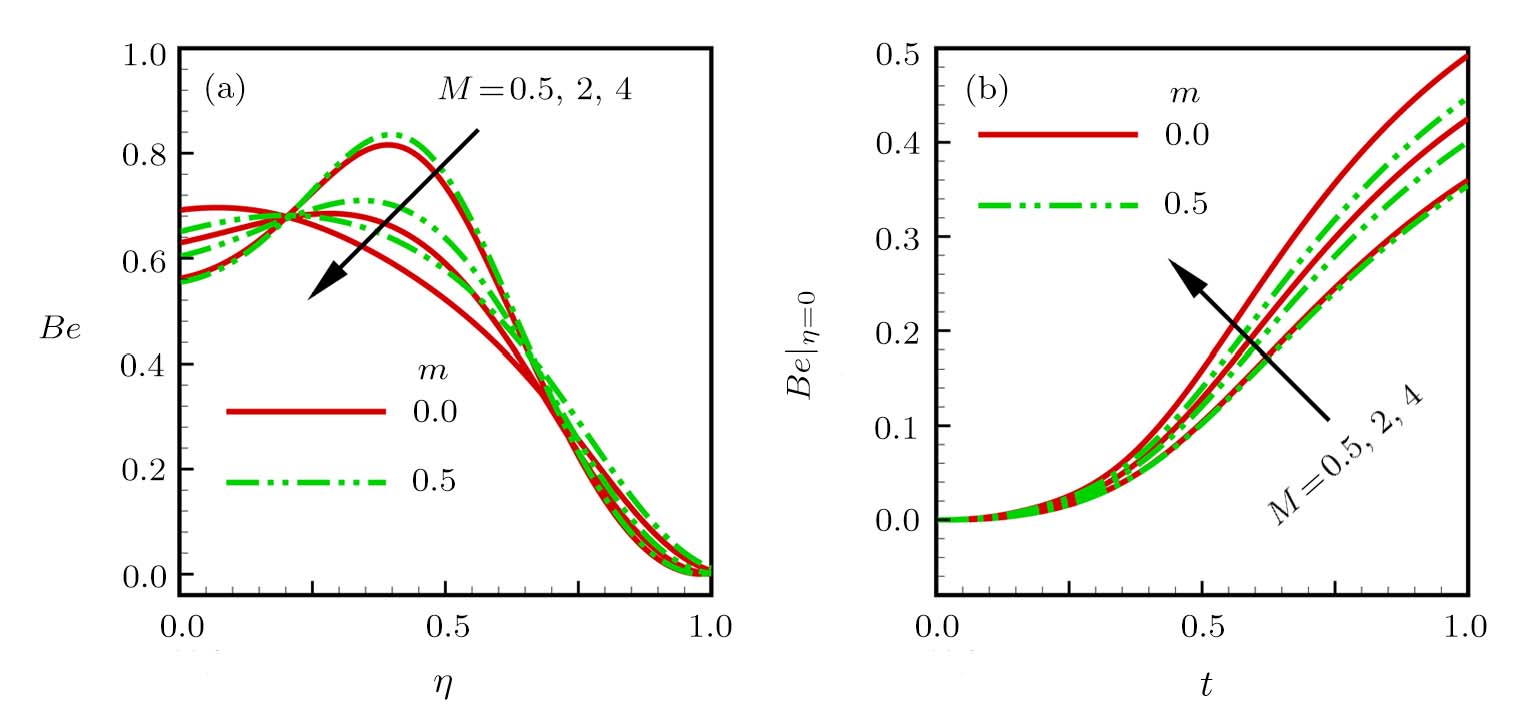 | Fig. 8 Effects of magnetic and Hall current parameters on Bejan number for (a) steady state and (b) transient state. |
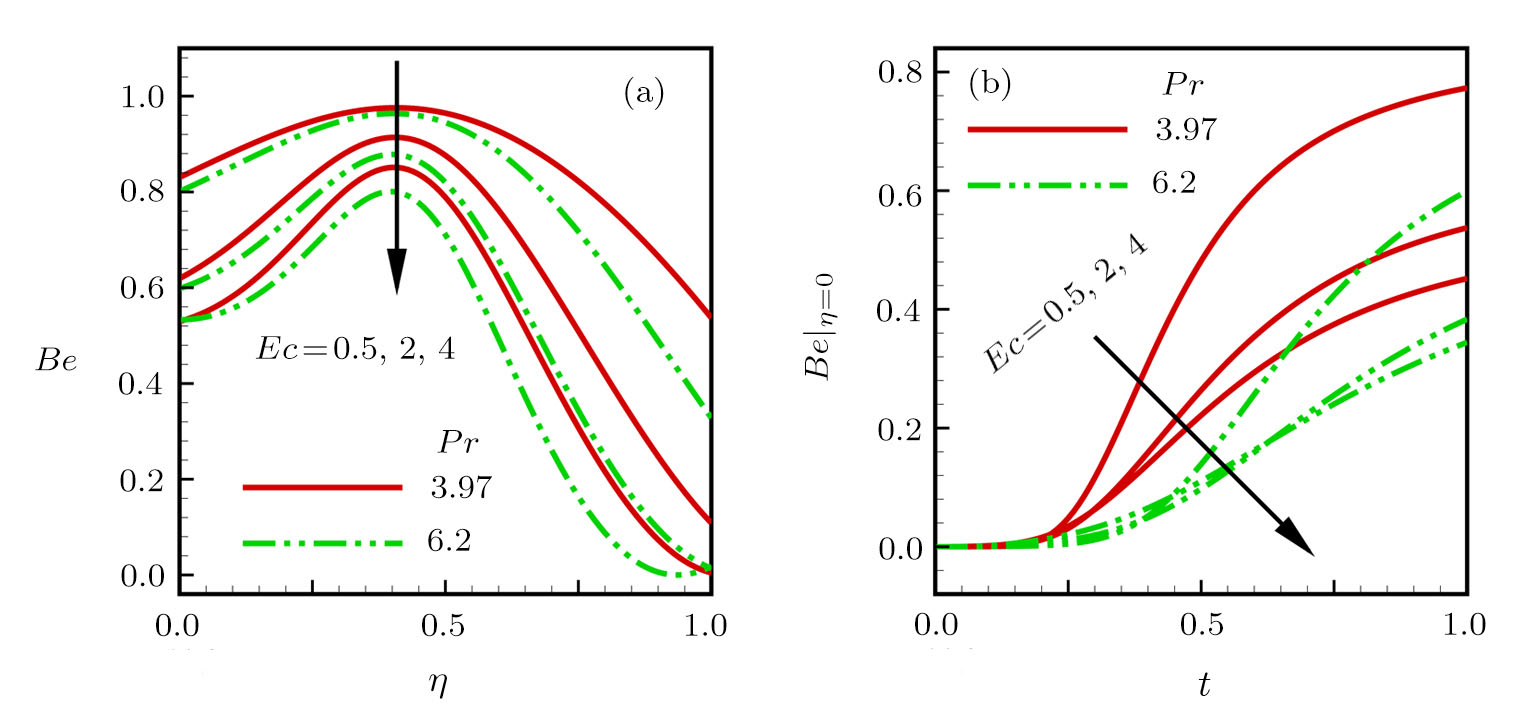 | Fig. 9 Effects of Eckert and Prandtl numbers on Bejan number for (a) steady state and (b) transient state. |
This article reports an unsteady two-dimensional laminar flow of an incompressible, electrically and thermally conducting fluid across the space separated by two infinite rotating permeable walls. The effects of entropy generation, Hall and slip effects on the two-dimensional MHD flow are considered within the current flow channel. The unsteady systems of dimensionless PDEs are solved by implementing the Finite Difference Scheme. To achieve the accurate movement of the laminar MHD flow in terms of velocity, temperature, skin friction coefficient, Nusselt and Bejan numbers, the pertinent parameters such as Re, t, R0, δ, M, Ec, Pr and γ have been fixed to some constant values. Furthermore, the three-dimensional graphical representations of the streamlines are presented, which ensure the precise movement of the flow field within the existing flow channel. It is expected that the current study would provide a platform for solving the system of nonlinear PDEs of the other unexplored and unsolved fluid flow models that are linked to the two-dimensional unsteady MHD flow in rotating fluid flow passages. It is further believed that the current study would be beneficial in the field of micromixing technology by enhancing exergetic effectiveness through device design for efficient operation and thermodynamic efficiency.
| [1] | |
| [2] | |
| [3] | |
| [4] | |
| [5] | |
| [6] | |
| [7] | |
| [8] | |
| [9] | |
| [10] | |
| [11] | |
| [12] | |
| [13] | |
| [14] | |
| [15] | |
| [16] | |
| [17] | |
| [18] | |
| [19] | |
| [20] | |
| [21] | |
| [22] | |
| [23] | |
| [24] |


